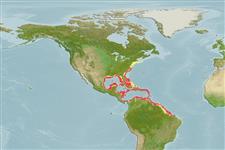Common names from other countries
>
Eupercaria/misc (Various families in series Eupercaria) >
Lutjanidae (Snappers) > Lutjaninae
Etymology: Lutjanus: Malay, ikan lutjan, name of a fish.
More on author: Cuvier.
Environment: milieu / climate zone / depth range / distribution range
Ecologia
marinhas associadas(os) a recifes; intervalo de profundidade 20 - 200 m (Ref. 9626), usually 80 - 150 m (Ref. 55). Subtropical; 43°N - 3°S, 100°W - 38°W (Ref. 55227)
Western Atlantic: as far north as North Carolina, USA and Bermuda south to Trinidad and northern Brazil; including the Gulf of Mexico (Ref. 9626). Very common in the Caribbean, particularly the Antilles.
Comprimento de primeira maturação / Tamanho / Peso / Idade
Maturity: Lm 28.7, range 21 - 25 cm
Max length : 75.0 cm TL macho/indeterminado; (Ref. 9710); common length : 50.0 cm TL macho/indeterminado; (Ref. 55); peso máx. publicado: 14.0 kg (Ref. 9710)
Espinhos dorsais (total) : 10; Raios dorsais (total) : 14; Espinhos anais: 3; Raios anais : 8. Preopercular notch and knob weak. Scale rows on back rising obliquely above lateral line. Mainly scarlet red, silvery on lower sides and belly; fins are yellowish to orange. A prominent black blotch is at the base and in axil of pectoral fins.
Adults inhabit deeper waters over sandy or rocky bottoms and near drop-offs and ledges. Young occur in shallower water, often between about 35 and 50 m. Feed mainly on fishes. Good food fish, it is marketed mostly fresh (Ref. 55).
Ciclo de vida ou comportamento de acasalamento
Maturities | Reprodução | Spawnings | Egg(s) | Fecundities | Larvas
Allen, G.R., 1985. FAO Species Catalogue. Vol. 6. Snappers of the world. An annotated and illustrated catalogue of lutjanid species known to date. FAO Fish. Synop. 125(6):208 p. Rome: FAO. (Ref. 55)
Status na Lista Vermelha da UICN (Ref. 130435)
CITES (Ref. 128078)
Not Evaluated
Ameaça para os humanos
Reports of ciguatera poisoning (Ref. 55)
Uso pelos humanos
Pescarias: espécies comerciais
Ferramentas
Relatórios especiais
Baixar XML
Fontes da internet
Estimates based on models
Preferred temperature (Ref.
115969): 18 - 26.2, mean 22.3 (based on 64 cells).
Índice de diversidade filogenética (Ref.
82804): PD
50 = 0.5000 [Uniqueness, from 0.5 = low to 2.0 = high].
Bayesian length-weight: a=0.01479 (0.01312 - 0.01667), b=2.97 (2.95 - 2.99), in cm Total Length, based on LWR estimates for this species (Ref.
93245).
Nível Trófico (Ref.
69278): 3.9 ±0.57 se; based on food items.
Resiliência (Ref.
120179): médio(a), tempo mínimo de duplicação da população 1,4 - 4,4 anos (K=0.10-0.70).
Fishing Vulnerability (Ref.
59153): High vulnerability (62 of 100).
